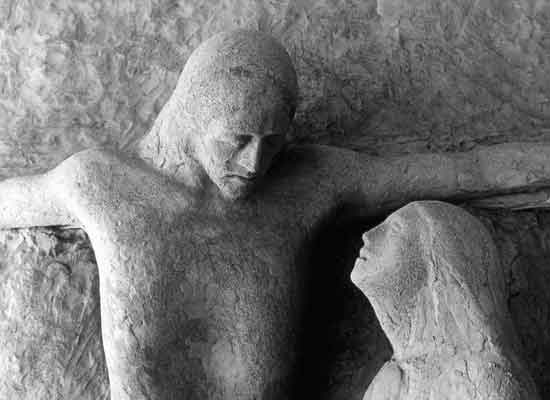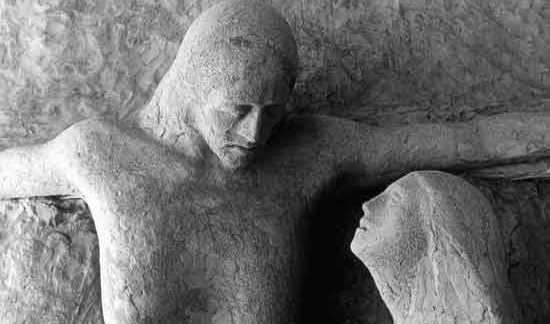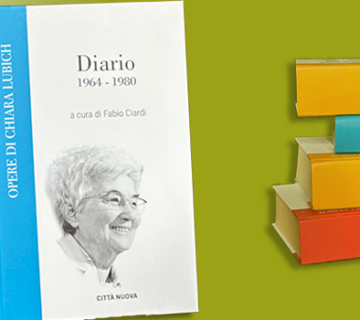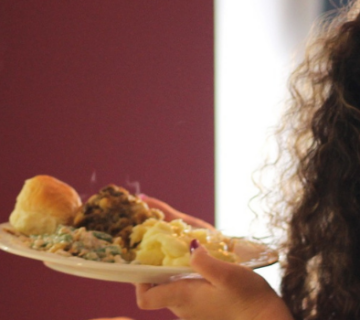
“The tragic mystery of the death on the Cross, when even Heaven and earth darken in horror and tremble, was poured forth upon the poor women beneath that gibbet.”
The Father had abandoned the Son; the Son had abandoned the Mother: Everything crumbled into horror and darkness. Only that woman remained standing, and she was entrusted with abandoned Humankind. Our destiny was in Her hands just as it was on that peaceful day when She spoke her first fiat. When the Father turned his gaze on those horrific hills that had become the pivot point of the universe, He saw Humankind clinging to that woman, under the gory and bloody sacrifice of the man-God.
“Martyr, and more than a martyr,” says Saint Bernard.
Beneath the Cross, Mary. We can truly say that Jesus somehow needed Her not only to be born, but also to die. She was there in that moment on the Cross when, abandoned by every person on earth, He felt abandoned by the Father in Heaven. Therefore, at the foot of the Cross he turned to the Mother: the Mother who had never deserted Him and who had triumphed over nature so as not to fall in that trial under which any woman would have crumbled. As Goethe seems to sense in Faust, on Calvary Mary and Jesus were joined in a “single suffering.”
Then, when the Son had died, the Mother continued to suffer. The dead Jesus was placed upon her lap: more helpless than when He had been a child. A dead God on His Mother’s lap! Right then, yes, she was queen. Since Jesus recapitulated humanity, [He] was all humanity of all times – guarded on the lap of Mary, who in that desolation appears as the Mother and Queen of the human family that walks the paths of sorrow. Her greatness was equal with Her anguish. But as we see, Her regality was nothing but a primacy in suffering: the only way for her to be the closest one, immediately next to the Crucifix.
If you think about Mary’s torment beneath the Cross, about the pain of the Mother upon the destruction of Her Son, willing victim of the sins of the world and of all the sufferings of all humankind, you can sense the immensity of the tragedy she endured, a cosmic tragedy. And you can measure our narrowness when we dedicate to her only a few sentences, a few brief prayers, a few gritty words . . . It seems to us a waste of time to meditate on, to weep over [it]: and we risk Eternity. Since inserting yourself into that suffering is to include yourself in the Redemption.
Let’s take our place with her beneath the Cross, choosing the role of a victim over that of an executioner, embracing suffering over the charm of wealth, the Cross over vice: so that we can then be with Mary in bearing on [our] lap, the bloodless body of Jesus, the Mystical Body that persecutions bleed to death. Always, during the hours when the Church is being executed and Christ suffers in Christians, you see Her again, Mary gathering the lacerated body to Her bosom.
And since Christ recapitulates Humanity, he identified with Humanity, so that the Church appears as Mary herself who gathers in the peoples in the midst of wars.”
Igino Giordani, Maria modello perfetto, (Rome: Città Nuova, 2001), p.124-129.


 Italiano
Italiano Español
Español Français
Français Português
Português




Bonjour,
je vous remercie pour les différentes publications très riches en enseignement. Je vous avoue que elles nous édifient et nous permettent de continuer à marcher sur le chemin de la foi.
Merci beaucoup.
Hääää? Kann mir den Text bitte mal von Kirchendeutsch auf deutsch übersetzen? Danke!!
Hallo Daniel, Sie haben völlig recht, es ist “Kirchendeutsch”. Aber es gehört dort auch hin. Diesen Artikel kann nur der verstehen, der im katholischen Glauben wirklich zuhause ist. Hinzu kommt, dass der Verfasser, Igino Giordani, ein bekannter italienischer Journalist seiner Zeit, schon lange tot ist (18. April 1980). Man kann seine Sprache nicht ins Moderne übertragen es ist die Sprache seiner Zeit. Aber wenn man den Artikel trotzdem liest und hinter das “Kirchendeutsch” schaut, …
…erkennt man mutige und zeitkritische Ansätze. Giordani liebt die Mutter Gottes ebenso wie die Menschen seiner Zeit. Dem “Häää” nach zu urteilen, gehören Sie zur jüngeren Generation, oder? Ich finde es beachtlich, dass Sie sich mit einem solchen Artikel befassen. Lassen Sie sich nicht durch die Sprache vertreiben, sondern bleiben Sie dran. Es lohnt sich wirklich, sich mit Maria unter dem Kreuz zu befassen. Hier liegt eine Fundgrube für die Bewältigung der großen Fragen unserer Zeit.